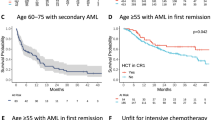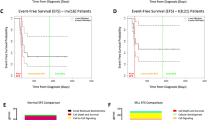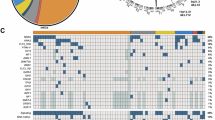Abstract
A phase II trial was conducted to determine which of the three possible two-drug combinations of diaziquone, etoposide and mitoxantrone was associated with the highest response rate in patients with relapsed or refractory acute myeloid leukemia (AML). Of the 167 patients (median age 55) with AML who entered the trial, 123 were in first relapse, 22 were in second relapse and 22 had failed to achieve complete remission (CR). CR rates were 30% for diaziquone and mitoxantrone, and 23% for the other two combinations (mitoxantrone/etoposide and diaziquone/etoposide), NS. Patients in first relapse had higher CR rates (40%) than other patients. Of the 166 patients who actually received treatment, 43 died before having either a CR or persistent leukemia. Non-hematologic toxicity was primarily mucosal with 24% of patients experiencing grade 3 or greater stomatitis on the two diaziquone arms, and 43% on the mitoxantrone/etoposide arm. The combination of diaziquone and mitoxantrone was selected for further testing in patients with AML.
This is a preview of subscription content, access via your institution
Access options
Subscribe to this journal
Receive 12 print issues and online access
$259.00 per year
only $21.58 per issue
Buy this article
- Purchase on SpringerLink
- Instant access to full article PDF
Prices may be subject to local taxes which are calculated during checkout
Similar content being viewed by others
Author information
Authors and Affiliations
Rights and permissions
About this article
Cite this article
Lee, E., George, S., Amrein, P. et al. An evaluation of combinations of diaziquone, etoposide and mitoxantrone in the treatment of adults with relapsed or refractory acute myeloid leukemia: results of 8722, a randomized phase II study conducted by Cancer and Leukemia Group B. Leukemia 12, 139–143 (1998). https://doi.org/10.1038/sj.leu.2400905
Received:
Accepted:
Published:
Issue date:
DOI: https://doi.org/10.1038/sj.leu.2400905



